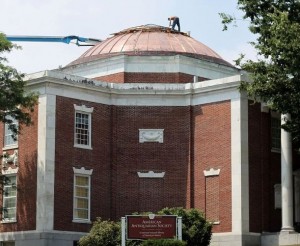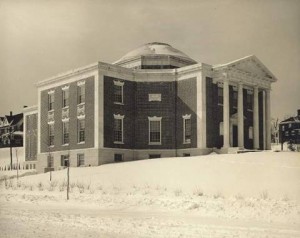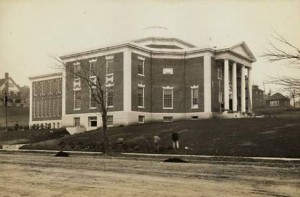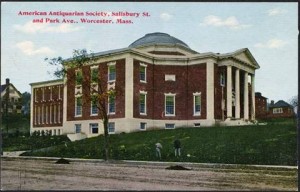 It’s funny (and a bit embarrassing for an organization that’s all about historical accuracy) when facts get obscured by the mists of time (and foggy memory) and then re-emerge with such clarity that one is left with only “Duh!” to say.
It’s funny (and a bit embarrassing for an organization that’s all about historical accuracy) when facts get obscured by the mists of time (and foggy memory) and then re-emerge with such clarity that one is left with only “Duh!” to say.
For some time now – through all the planning and the fundraising – we have been referring to our need to replace the original copper on the Society’s dome. Several times, in fact, I made reference to that copper as now being more than 100 years old, the current Antiquarian Hall having been built in 1910. But when the roofers began the replacement work this spring (they did great work – now completed), they started discovering things that surprised both them and me!
First, as they began to carefully remove the old copper they found that the flat roof areas that surround the dome were made of solid marble – huge blocks of it – although we had assumed that the marble was only a trim. They even discovered that the “wedding cake layers” leading up to the dome were also solid marble. Okay, I said to myself, so they built things solidly back in 1910. But when the roofers began to peel away the copper on the dome itself, we got even more puzzled. They found that the entire surface of the dome was constructed of flat sheets of a whitish stone (marble?), each cut into the shape of an isosceles trapezoid (yay for what we learned back in geometry!), and mortared, side by side, one to another. That seemed just totally weird. Why would they have gone to such trouble and expense to construct the dome entirely of stone, only to then cover it up with copper? But still I kept insisting to the roofer that the copper dated from the original 1910 construction. I was certain.
Certainly wrong, that is. Searching for answers, I went back to a set of my notes from the late 1990s (notes that were in a binder that was stashed not six inches from my computer monitor) in which I had traced the entire history of our buildings, back to our founding in 1812. Sure enough, there I found reference, in my own hand, to the fact that the copper cladding was added to the dome in 1920 to correct a decade of water seepage in the original stone roof. I even had taken note of the report of the October meeting for that year, which stated: “Under the authority granted by the Society at the April meeting the dome of the building has been covered with copper and the interior of the dome has been repainted at a cost of $4,389.30….” Boy, how times (and prices) have changed!
And so, with the benefit of hindsight, I started looking at the rest of evidence I had gathered over the years, right on my own computer. Judging from the size of the shrubbery, this photograph must have been taken during one of the first winters at 185 Salisbury (notice how smooth and white the surface of the stone dome appears):
… and compare it to this next photo…. Not only has the shrubbery grown taller, but — lo and behold — the dome is no longer smooth but now has raised ribs (just like the copper roof we recently replaced).
But it was these next two pictures that were “the smoking gun” for me. In the first one, the dome is clearly white and smooth…
… and here is a post-1920 postcard that is – without any question – derived from that very same photograph (right down to the piles of dirt in the gutter). But look what the colorist has done: given the dome a greenish patina! Duh!! Copper had arrived (although apparently the guys planting the shrubs never left).
So the fact is that the old copper on the dome was only 92 years old. May the new serve us as well as the old did.





Detective to the core; the truth will out.